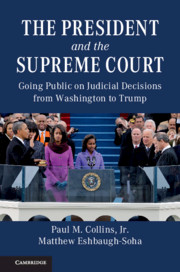Book contents
- The President and the Supreme Court: Going Public on Judicial Decisions from Washington to Trump
- The President and the Supreme Court: Going Public on Judicial Decisions from Washington to Trump
- Copyright page
- Dedication
- Contents
- Figures
- Tables
- Preface
- 1 Going Public and the Supreme Court
- 2 Going Public on Pending Decisions
- 3 Going Public on Decided Cases
- 4 The Tone of Presidential Rhetoric on Supreme Court Decisions
- 5 Presidential Calls to Congress
- 6 Presidential Leadership of News Coverage
- 7 Presidents and Public Opinion
- 8 Going Public on Supreme Court Cases before the Modern Presidency
- 9 Conclusions
- Notes
- References
- Index
4 - The Tone of Presidential Rhetoric on Supreme Court Decisions
Published online by Cambridge University Press: 13 December 2019
- The President and the Supreme Court: Going Public on Judicial Decisions from Washington to Trump
- The President and the Supreme Court: Going Public on Judicial Decisions from Washington to Trump
- Copyright page
- Dedication
- Contents
- Figures
- Tables
- Preface
- 1 Going Public and the Supreme Court
- 2 Going Public on Pending Decisions
- 3 Going Public on Decided Cases
- 4 The Tone of Presidential Rhetoric on Supreme Court Decisions
- 5 Presidential Calls to Congress
- 6 Presidential Leadership of News Coverage
- 7 Presidents and Public Opinion
- 8 Going Public on Supreme Court Cases before the Modern Presidency
- 9 Conclusions
- Notes
- References
- Index
Summary
Chapter 4 examines the tone of presidential discussions of Supreme Court cases, focusing on why presidents discuss cases in positive, negative, and neutral lights. We argue that presidents alter the tone of their remarks about the Court’s decisions in an effort to build public support for their presidencies, shape how the public views the constitutional issues at play, and influence the implementation of the Court’s decisions in the bureaucracy and in Congress. For example, a president happy with the Court’s decision can praise the decision and assure the country that he will take all steps necessary to ensure it is implemented. Conversely, a president displeased with a decision can criticize that decision and encourage Congress to take action to alter or reverse the decision, thus signaling that the fight over the case has not ended. Consistent with our theoretical expectations, we find that presidents criticize cases they disagree with ideologically; those that declare laws unconstitutional; and those decided by minimum winning coalitions. Conversely, presidents tend to praise salient Supreme Court decisions that support their preferred ideological positions.
Keywords
- Type
- Chapter
- Information
- The President and the Supreme CourtGoing Public on Judicial Decisions from Washington to Trump, pp. 80 - 103Publisher: Cambridge University PressPrint publication year: 2020



